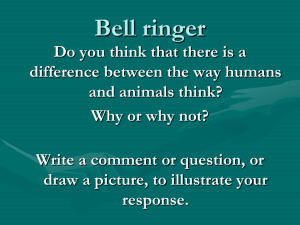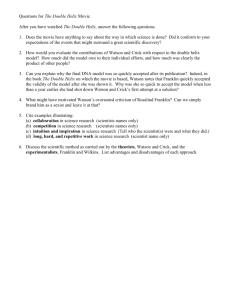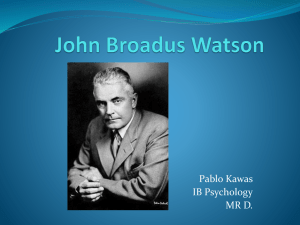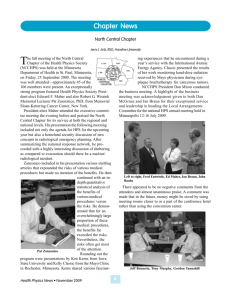John B. Watson Dima Obari ID #: 201101103 American University of
advertisement
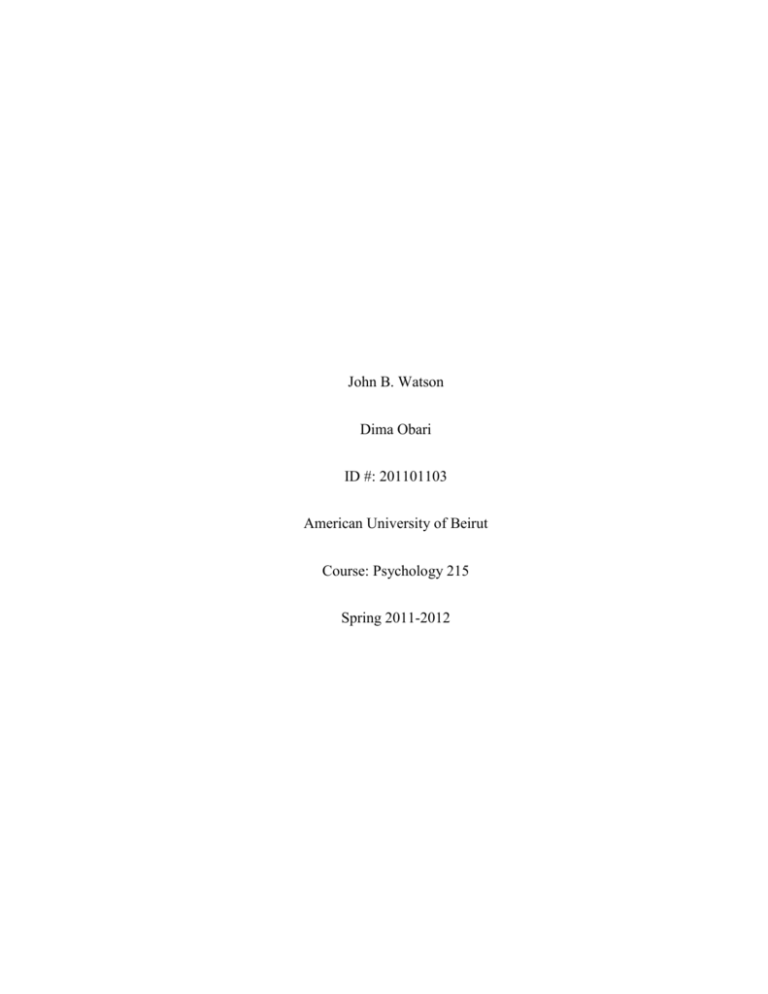
John B. Watson Dima Obari ID #: 201101103 American University of Beirut Course: Psychology 215 Spring 2011-2012 Abstract This paper aims to depict a picture of John Broadus Watson, a famous American psychologist, thereby providing an understanding of his beliefs and appraising his contributions against the intellectual background from which he arose and the diverse events that he encountered in his life. As we shall see, Watson is best known for his contributions to behaviorism and functionalism, his thoughts on child rearing, and his famous experiment titled “Little Albert”. Background John Broadus Watson was born in 1878 to a poor family in Travelers Rest, South Carolina. He was the son of a petty farmer and a very religious woman. His father, whom he was closer to, left him and ran off with another woman. Subsequently, his mother sold the farm and together they moved to Greenville (Encyclopedia, 2008; Hunt, 2007). In childhood, Watson was torn between the contrasting behaviors modeled by his parents. He became apathetic and indolent, did poorly in school and was teased by his classmates. Like his father, he had a penchant for violence and was arrested twice for minor violations of the law (Hunt, 2007). Education However, things seem to have taken an interesting shift in his life. Indeed, Watson, made use of his mother's connections and got himself accepted in Furman College in Greenville, at the early age of 16. Although he had fist intended to study for the Baptist ministry, he soon turned against religion and started finding interest in psychology. He graduated at the age of 21, and taught in the same college for a year (Encyclopedia, 2008; Hunt, 2007). After that, Watson attended the University of Chicago to study philosophy with John Dewey, based on the recommendation of his old professor George Moore. His mother had passed away, and thus he initially arrived in Chicago with only fifty dollars to his name, and supported himself with several odd jobs inside the university. He later did his doctoral research on how the level of brain development in young rats was related to their ability to learn mazes and open doors to get food. He was following the latest trend in psychology, but his research also reflected his preference for working with animals. Indeed, although Watson exuded self-assurance, he was uncomfortable around people, perhaps due to his father’s absence, which he considered unforgivable (Hunt, 2007). As soon as he earned his Ph.D, he was offered an assistantship in experimental psychology, and thus did research on animal learning, specifically on the relationship between sensory input and learning, and bird behavior. He taught rats to make their way through a miniature replica of the maze of the Hampton Court, Henry VIII’s royal retreat outside London. He found, by eliminating the rats’ sensory cues one by one, that kinesthetic cues were the key elements in the rat’s learning process. Soon after, he was promoted to instructor, then professor-elect, and finally he was offered a chair of psychology at John Hopkins University (Hunt, 2007). Functionalism John Broadus Watson was not only an experimental psychologist, but also a systematic thinker, a social philosopher and a metaphysician. However, these four sides of him did interfere with each other, as we will see throughout the text. Watson, being a radical innovator and a man of action rather than a thinker, rebelled against structuralism and the functionalism of his teachers at the University of Chicago. He made the break between structuralism and functionalism, thus leading to modern psychology. He is now considered one of the greatest functionalists, though not the last of them. In fact, the functionalists, along with Watson, made the emphasis on complete and comprehensive process laws a truism, which was made clear in Watson’s article “Psychology as the behaviorist views it”. Watson was committed to his theory of metaphysical behaviorism, in which he claims that there are no interacting minds, completely denying in the process the existence if the mind. For him, the inner life is nothing metaphysical, but rather the availability, originality and adequacy of the implicit verbal response. However, his biggest methodological contribution to Functionalism was his methodological behaviorism thesis, which was a combination of the truism mentioned earlier, and his theory of metaphysical behaviorism. Its main claim is that behavior is, in principle, predictable from the past behavioral, physiological and environmental variables (Bergmann, 1956). That said, Watson was not an ideological reductionist, as he knew he could expect no help from the physiological psychologists of his day, and had a naïve and almost superstitious distrust of any appeal to the action of the central nervous system (Bergmann, 1956). Behaviorism The combined influence of Dewey, James Rowland Angell, Henry Herbert Donaldson and Jacques Loeb led Watson to reject all conjectures about invisible mental processes and develop a highly descriptive, objective approach to the analysis of behavior that he would later call "behaviorism" (Encyclopedia, 2008). He voiced his views at psychological meetings in 1908 and 1912, and later published Psychology as the behaviorist views it, which is considered the behavioral manifesto and where he made it clear that in order for psychology to become a science, it had to become independent from the mind: “Human psychology has failed to make its good claim as a natural science. Due to a mistaken notion that its fields of facts are conscious phenomena and that introspection is the only direct method of ascertaining these facts […]. It is granted that the behavior of animals can be investigated without appeal to consciousness […]. This suggested elimination of states of consciousness as proper objects of investigation in themselves will remove the barrier which exists between it and the other sciences” (p.176-177). Early behaviorism or Watsonianism was more of a school than Functionalism in its maturity. It relied mainly on Watson’s both metaphysical and methodological behaviorism, along with animal work, and included on three pseudo-methodological beliefs. The first one would be the peripheral theory of thought and glandular theory of emotion. These theories were propounded dogmatically and on theological grounds, and saved him from ideological reductionism. It is tied up with his antimentalism. The motive behind it was clear in his “Image and affection in the behavior”, which he read before the Columbia seminar. His preference is the result of his activism: he realized that detailed knowledge and control of the Central Neural System would probably come last. At the time, Kulpe had distinguished between peripherally and centrally aroused sensations. A peripheral stimulation would be a sensation of something physical, which is around us. However, Watson confused ‘centrally aroused’ with ‘uncaused’. He thus concluded that images, which are centrally aroused sensations, do not exist, as they would come from the interacting mind. As for peripherally aroused sensations, he was convinced they were produced in the sex glands. Let us add that, although Watson fiercely objected to psychoanalysis’ mentalism, he understood Freud, recognized his significance, and was drawn to the insight that man’s behavior, however complex, can and must be causally explained in terms of primary needs. The second tenet was the inclination to favor contiguity over reinforcement theories of learning. Indeed, as a reaction to speculative Darwinism, Watson distrusted reinforcement theories and probably associated them with metaphysical purposive, thought it is clear today that these two concepts are unrelated. The third tenet is related to his social philosophy, and it is his denial of individual differences. According to Watson, a child at birth is equipped with nothing but the structure of its body and a few elementary unlearned responses; all the rest comes from learning. (Bergmann, 1956). Consider his most famous quotation: “Give me a dozen healthy infants, well-formed, and my own specified world to bring them up in and I'll guarantee to take any one at random and train him to become any type of specialist I might select – doctor, lawyer, artist, merchant-chief and, yes, even beggar-man and thief, regardless of his talents, penchants, tendencies, abilities, vocations, and race of his ancestors. I am going beyond my facts and I admit it, but so have the advocates of the contrary and they have been doing it for many thousands of years” (Watson, 1930). Classical conditioning: little Albert Indeed, as Watson is convinced, the child is born with only three emotional patterns, that is love, rage and fear. In his famous little Albert experiment, John B. Watson paired the sight of a rats with noise made by striking a hammer upon a suspended bar, based on the Pavlovian classical conditioning. He and his graduate assistant Rosalie Rayner performed this experiment on Albert B., who was staying at a hospital and was chosen for his high stability; indeed, Albert was quite stolid and unemotional, and was never seen in a state of fear and rage. The experiment occurred at different intervals of time. Many precautions were taken in order to help with the validity of the results. Indeed, the child was first tested, at nine months of age, with loud sounds, and showed a fear reaction as expected. He was startled and broke into a crying fit. The first few parings helped determine the establishment of conditioned emotional responses. They were performed on two occasions, when Albert was 11 months 3 days of age, and again a week later. It was clear that the pairings between the sound and the rat caused Albert to avoid the rat, and in some instances, react violently to it. Note that Watson and Rayner presented him, after about every pairing, with blocks. The fact that the child would still reach for the blocks and manipulate them, but avoid the rat, showed that the fear developed was specific to the object the sound was paired with, that is, the rat. The pairings that followed help determine whether this fear transferred to similar objects, and were made when Albert was 11 months 15 days of age, and again 5 days later. Indeed, Albert cried at the sight of both a rat and a rabbit. He also avoided a fur coat and a piece of cotton wool that were presented to him. Additionally, the child showed a certain fear reaction to the sight of a dog, which significantly increased when that same dog barked at him. However, when Albert was taken to a different room, his reactions slightly differed. The last pairings occurred one month later, right before Albert was taken out of the hospital. They helped determine the effect of time on conditioned responses. Indeed, Albert cried at the sight of a santa claus mask and a fur coat, which shows that conditioned emotional responses as well as those conditioned by transference persist, although with a certain loss of intensity of the reaction, for a period longer than one month. If it weren’t for Albert’s sudden departure, Watson and his assistant would have had the occasion to test several methods of “detachment”, that is, removal of the conditioned responses. One method would’ve been habituating the child to the stimuli. Another one would have involved reconditioning by pairing the stimuli with the either food or the stimulation of the erogenous zones (skin, lips, nipples and sex organs). One last option proposed by Watson was having the child touch the feared object through imitation. During this experiment, Watson also made some additional observations. He noted that thumb sucking is a form of love stimuli that acts as a compensatory device and blocks fear and noxious stimuli. Other love stimuli include: stroking the erogenous zones, patting and rocking. Watson also noted that there is an equal primacy of fear, love and possibly rage. He concluded that emotional disturbances in adults cannot be traced back to sex alone; they must be traced to conditioned and transferred responses set up in infancy and early youth (Watson & Rayner, 1920). Child Rearing John Broadus Watson is also known for his radical position taken in regards to child rearing. Indeed, in his book Psychological Care of Infant and Child, he recommends strict emotional control, as well as emotional distance and focuses on the mother in his chapter “The dangers of too much mother love” (1928): "Treat them as though they were young adults… Let your behavior always be objective and kindly firm. Never hug and kiss them. Never let them sit on your lap. If you must, kiss them once on the forehead when they say good night. Shake hands in the morning… You all be utterly ashamed of the mawkish, sentimental way you have been handling it" (Watson 1928, p.81-82). He also adds that, a mother coddles her children to make them happy, but there’s also a darker, unrecognized maternal motivation: "She is starved for love… it is at bottom a sex-seeking response in her" (p. 80); "mother love is a dangerous instrument… which may inflict a never healing wound" (p.87). His radical views on child rearing may have been caused by the absence of his father, and the fact that he was emotionally frozen (Hunt, 2007; Shields & Koster, 1989). Marketing So far we have discussed the most prominent contributions of John Broadus Watson to psychology, but Watson also contributed significantly to the field of marketing, by applying some of his knowledge in psychology. While he was at John Hopkins University, Watson had a love affair with his graduate assistant Rosalie Rayner. Later, his wife found out about it by going through their love letters, but Watson refused to put an end to this affair. The affair gained so much publicity that the president of the university had him fired. Later, Watson married Rayner, had two children with her, and remained with her until she died from dysentery (Hunt, 2007). All that is to say why Watson had turned away from psychology to marketing. He started working in the J. Walter Thompson advertising agency and conceived many of the firm’s most successful campaigns, particularly for Ponds cold cream and other personal-care products. He is also credited with popularizing the coffee break during an ad campaign for Maxwell House coffee (Hunt, 2007). Watson believed that in order for advertising to be effective, it should appeal to one of the three innate emotions. He also believed in doing market research, which implies that there are applied, scientific approaches to advertising, For instance, according to C. James Goodwin in A History of Modern Psychology, Watson used “demographic data to target certain consumers (p.316). Conclusion All in all, John Broadus Watson is without a doubt a major figure, to whom we owe in part the emergence of behaviorism and modern psychology, and who has influenced our lives in many diverse aspects, including the media. His place in the history of our civilization is not inconsiderable and it is secure. References: Bergmann G. (1956). The contribution of John B. Watson. Psychological Review, Vol 63(4), Jul 1956, 265-276. Encyclopedia (2008). "Watson, John Broadus." Complete Dictionary of Scientific Biography. Goodwin, C.J. (1999). The origins of behaviorism: A new life in advertising. A History of Modern Psychology (pp. 315-317). New York: John Wiley & Sons, Inc. Hunt M. (2007), The story of psychology, p.287-296. Watson J. B. (1913). Psychology as the behaviorist views it. Psychological Review, vol 101, No. 2, 248-253. Watson J. B., Rayner R. (1920). Conditioned emotional reactions. Journal of Experimental Psychology, vol 3, No. 1 Watson, J. B. (1927). "The Weakness of Women." Nation 125:9-10. Watson J. B. (1928). Psychological Care of Infant and Child. New York: W.W. Norton. Watson J.B. (1930). Behaviorism. University of Chicago press, p. 82. Shields S. A., Koster B. A. (1989), Emotional stereotyping in child rearing manuals, 1915-1980, Social Psychology Quarterly, Vol. 52, No. 1, 44-55


